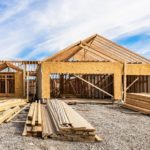‘We’re just looking at every opportunity we have to turn the dial as much as we can to help support homeowners in this difficult market,’ FHA official says
Housing affordability hit a 39-year low this year, and the federal government says it’s determined to do something about that.
Rising mortgage rates and home prices have made it a lot more expensive to buy a home.
For a typical household, buying a median-priced home entails spending nearly 41% of their income just to cover the monthly principal and interest payments, up from a historical average of less than 25%, according to data from Intercontinental Exchange.
The 30-year was averaging at 7.61% as of Nov. 10, according to the Mortgage Bankers Association on Wednesday. The median national list price was $425,00 in September, according to Realtor.com.
“We’re just looking at every opportunity we have to turn the dial as much as we can to help support homeowners in this difficult market,” Julia Gordon, the assistant secretary for Housing and Federal Housing Commissioner, told MarketWatch.
Gordon guides policy that impacts how Federal Housing Administration loans are underwritten. She is a Biden administration appointee.
Gordon spoke to MarketWatch on the heels of the release of the FHA’s annual report, which provides the agency’s year-end results.
The FHA, a government agency which provides mortgage insurance for multiple types of homes, has helped 765,000 home buyers and homeowners, and more than 33,000 seniors, with their mortgage needs over the last year, according to the report.
The federal agency’s eponymous FHA loan may be familiar to home shoppers, as it lets buyers to put down as little as 3.5% down on a home, allows for a lower credit score, and better interest rates.
Marcia L. Fudge, the secretary for Housing and Urban Development, also stressed how the agency was addressing housing affordability.
“Here at HUD, our Federal Housing Administration team is laser-focused on using every tool we have to make homeownership more affordable and more accessible,” Fudge told MarketWatch. “Today’s report shows that, despite larger market challenges in 2023, we continued to deliver on this mission, allowing nearly half a million to become homeowners for the first time.”
Mortgage demand falls to multi-decade low
Mortgage lenders have had a rough year. With rates sharply rising, buyer demand has dried up, and mortgage applications have fallen to the lowest level since 1995.
Lenders are bearing steep losses. In the third quarter of 2023, they’ve lost $1,015 per loan, and it’s the sixth straight quarter of losses, the Mortgage Bankers Association said on Tuesday.
But the FHA said it hasn’t seen a sharp drop in demand. While the agency does not lend to home buyers, it insures mortgages. Its annual report noted that the FHA maintains a “strong, well-capitalized insurance fund” and the serious delinquency rate was 3.93% at the end of the fiscal year 2023, similar to the rate prior to the onset of the coronavirus pandemic.
The serious delinquency rate reached a peak in November 2020 during the pandemic, the FHA said.
“Like everyone in the mortgage industry, volumes this year were down,” Gordon told MarketWatch. “We’re facing unprecedented housing supply shortages, skyrocketing home prices during the COVID period, and it is difficult for people to get in right now.”
“But the FHA was able to take a few actions over the past year that really helped,” she added. “While our volumes also dropped, it did not drop commensurate with the market as a whole.”
FHA’s recent moves
Over the last year, the FHA announced a series of changes aimed at making homes more affordable.
From allowing home buyers to include rental income from accessory dwelling units during the mortgage underwriting process to reducing the mortgage insurance premium on FHA-insured mortgages — which saves borrowers up to $800 a year — the agency said it has attempted to address the costs associated with buying and owning a home.
Particularly with reducing the annual MIP charged to home buyers, “in this economy, anyone reducing the price of anything is noteworthy. And that really helped people not just be able to afford their monthly payment, but in many cases it actually helped people qualify for the mortgage,” Gordon said.
The move to help buyers use prospective income from renting out an ADU to factor into their qualifying income was specifically aimed at improving housing supply, Gordon explained.
“I’m very excited about the ADU policy. In California they are very advanced right now in building ADUs, and that is becoming a meaningful and significant part of the supply increase,” Gordon said.
California, one of the most expensive states to buy a home, has been leading the nation when it comes to ADUs.
Construction of ADUs has risen from just 1,100 in 2016 to 23,600 in 2021, according to a report by John Burns Real Estate Consulting. In Santa Maria in 2022, ADUs alone represented 46% of permits for new homes, the report noted.
Making financing easier for people to afford homes with an ADU attached incentivizes more construction of denser housing, Gordon said, and “that’s a real win for housing supply.”
It’s also a way to work around zoning regulations, which are dictated at the local level. Zoning rules spell out how land can be used, and whether an area is zoned as residential or commercial, or for single-family or multi-family housing.
“We see jurisdictions all over the country talking about this and whether it can be a solution for them. And I think it can be, because the zoning changes that are needed to build ADUs tend to be easier to achieve than more sweeping zoning changes,” Gordon explained.
“And it’s clear that this is a product that homeowners are interested in offering, [and] renters are interested in using,” she added.
The FHA official also said that the agency is looking at changes with 203k loans, which are government loans that are more commonly known as a rehab or a renovation loan.
With a 203k loan, a buyer can use the money to fund both the home they’re purchasing as well as renovations that are required to fix up the home. It’s backed by the FHA, and can be a 15-year, 30-year fixed, or an adjustable-rate mortgage.
“There’s so much of our housing stock in this country that is aging,” Gordon said. “And houses need reinvestment. So if we’re going to keep those properties from going offline, which will hurt housing supply, we need to make sure that people have a way to borrow the money they need to fix them up.”
Some have turned to buying fixer-uppers because it’s considered an easier entry point into owning a home. There’s even an Instagram account called Cheap Old Houses dedicated to inspiring home buyers to join the cause of rehabbing older homes. It boasts more than 2 million followers.
“Many households get to a point where they are going to buy and it isn’t going to matter whether the rate is a few basis points one way or the other,” Gordon said, reflecting on the tough housing market buyers have faced in 2023. “What we’re trying to do is make sure those people can buy when it’s time for them to buy.”
Source: marketwatch.com













